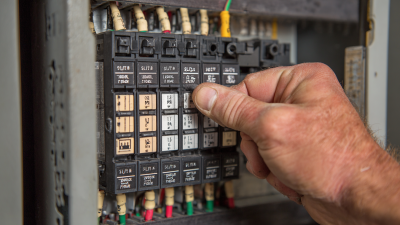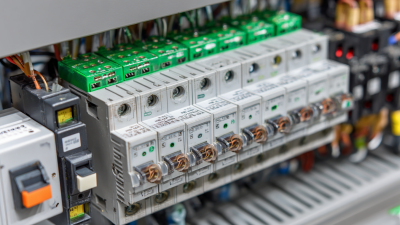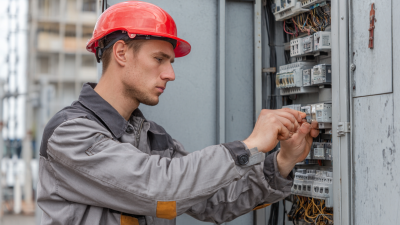How to Choose the Right Circuit Protection Solutions for Your Devices
When it comes to ensuring the longevity and reliability of electronic devices, choosing the right circuit protection solutions plays a crucial role. Circuit protection is not merely a technical requirement; it is an essential component of device design that safeguards against potential dangers such as overcurrent, short circuits, and voltage spikes. With a wide array of options available in the market, from fuses and circuit breakers to polyfuses and MOVs (Metal Oxide Varistors), making an informed decision can be overwhelming. This guide will equip you with the knowledge needed to navigate through various circuit protection methods, helping you understand the specific needs of your devices and the environments they operate in. By evaluating factors such as the expected current load, voltage levels, and potential environmental threats, you will be better positioned to select the most effective solutions, ultimately enhancing the performance and safety of your electronic applications.

Identifying the Specific Electrical Requirements of Your Devices
 When selecting circuit protection solutions, it's crucial to first identify the specific electrical requirements of your devices. Each device has unique voltage and current specifications, and understanding these is vital to preventing damage from surges or short circuits. Start by consulting your device's technical documentation, which often outlines the necessary ratings and operational limits. This foundational knowledge will guide your protection selection process.
When selecting circuit protection solutions, it's crucial to first identify the specific electrical requirements of your devices. Each device has unique voltage and current specifications, and understanding these is vital to preventing damage from surges or short circuits. Start by consulting your device's technical documentation, which often outlines the necessary ratings and operational limits. This foundational knowledge will guide your protection selection process.
Tips: Always consider the environment in which your devices will operate. Factors such as temperature, humidity, and potential exposure to moisture can affect how circuit protection devices perform. For example, certain fuses and breakers may be designed specifically for harsh conditions, ensuring reliable operation under various stresses.
Additionally, take into account the potential for system upgrades and future changes. Choosing modular protection solutions can facilitate easier adaptations as your device requirements evolve. It's also wise to engage with manufacturers or experts who can offer tailored advice based on your device's specifications and intended use. This proactive approach ensures you select the most effective and reliable circuit protection for your unique applications.
Understanding Different Types of Circuit Protection Solutions
When selecting circuit protection solutions, it's crucial to understand the various types available to safeguard devices effectively. Fuses are one of the oldest and simplest forms of protection, acting as a sacrificial component that breaks the circuit when excessive current passes through. This immediate response prevents damage to sensitive components but requires replacement once activated.
Another popular option is circuit breakers, which can be reset after tripping, making them more convenient for repeated use. They come in various forms, including thermal and magnetic breakers, each offering unique advantages depending on the application. Additionally, surge protectors play a vital role by defending devices against voltage spikes, which can occur from lightning strikes or power surges. By comprehensively understanding these options, individuals and businesses can make informed decisions when choosing the appropriate circuit protection solution for their specific needs.
How to Choose the Right Circuit Protection Solutions for Your Devices
| Circuit Protection Type | Description | Key Features | Applications |
|---|---|---|---|
| Fuses | A device that protects circuits by breaking the connection when current exceeds a certain level. | One-time use, varied ratings, inexpensive. | Power supplies, lighting systems, home appliances. |
| Circuit Breakers | Automatically interrupts the circuit when it detects an overload or a fault. | Reusable, adjustable ratings, fast response time. | Industrial equipment, residential wiring, renewable energy systems. |
| Polymeric Positive Temperature Coefficient (PPTC) | Resistor that increases resistance with temperature, protecting against overloads. | Resettable, compact size, low power loss. | Consumer electronics, telecommunications, computers. |
| Surge Protectors | Devices that protect against voltage spikes by diverting excess voltage. | Clamping voltage, response time, capacity rating. | Computers, home appliances, industrial machinery. |
Evaluating the Environment and Conditions of Device Usage
When selecting circuit protection solutions for devices, evaluating the environment and usage conditions is crucial. According to a report by Frost & Sullivan, approximately 85% of electronic failures can be traced back to environmental factors such as temperature fluctuations, humidity levels, and exposure to dust or chemicals. Thus, it’s essential to assess the specific conditions under which the device will operate. For instance, devices used in industrial settings may require robust protection against harsh contaminants and extreme temperatures that standard consumer-grade solutions cannot withstand.
Moreover, considerations regarding the electrical environment are equally important. A study by the Electric Power Research Institute (EPRI) indicates that transient voltage spikes can lead to catastrophic failures in sensitive electronics. Devices exposed to high-voltage surges, common in areas prone to lightning strikes or power grid instability, necessitate advanced protective measures like surge protective devices (SPDs). Understanding these environmental conditions will enable manufacturers to choose appropriate circuit protection solutions that not only enhance device longevity but also ensure optimal performance in various settings.
Selecting the Appropriate Rating and Specifications for Protection Devices
 When selecting circuit protection solutions for your devices, understanding the appropriate ratings and specifications is crucial. The first step is to evaluate the electrical characteristics of your application, including voltage, current, and power requirements. Identify whether the device will experience steady-state loads or transient surges, as this will influence the choice of protection devices. Fuse ratings, for instance, need to be selected based on their ability to safely interrupt excessive currents without nuisance tripping during normal operation.
When selecting circuit protection solutions for your devices, understanding the appropriate ratings and specifications is crucial. The first step is to evaluate the electrical characteristics of your application, including voltage, current, and power requirements. Identify whether the device will experience steady-state loads or transient surges, as this will influence the choice of protection devices. Fuse ratings, for instance, need to be selected based on their ability to safely interrupt excessive currents without nuisance tripping during normal operation.
Additionally, consider environmental factors such as temperature, humidity, and exposure to chemicals. These conditions can affect the performance of protection devices. It's important to choose components that not only meet electrical specifications but also withstand the operating environment. Ratings such as IP (Ingress Protection) and operating temperature ranges will guide you in ensuring that the selected circuit protection solution remains reliable under various conditions. Properly assessing these factors will help in selecting the most effective protection devices, ensuring the longevity and safety of your electronic systems.
Implementing and Testing Your Chosen Circuit Protection Solutions
When implementing circuit protection solutions for your devices, it is essential to consider various factors that ensure reliability and safety. First, identify the specific risks your devices might face, such as overcurrent, overvoltage, or thermal events. This will help you select the appropriate protection components, like fuses, circuit breakers, or surge suppressors, tailored to the operational environment of your devices. Ensure that these components are rated for the correct voltage and current levels to prevent premature failure.
Once the circuit protection solutions are installed, thorough testing is crucial to validate their effectiveness. Simulate potential fault conditions to assess how well the protection measures respond under stress. Use equipment such as oscilloscopes and multimeters to monitor the behavior of your devices during these tests. Conducting regular maintenance checks and assessments can help identify any signs of wear or degradation in the protection components, allowing for timely replacements or adjustments to maintain optimal safety and performance standards.
Choosing the Right Circuit Protection Solutions for Your Devices
Related Posts
-

10 Essential Tips for Surge Protection: Protect Your Electronics with 99% Effectiveness!
-

9 Essential Tips for Choosing the Right Home Circuit Breaker
-

Ultimate Guide to Choosing the Right Surge Protection Circuit Breaker for Your Needs
-

How to Optimize Power Distribution Systems for Enhanced Efficiency and Safety
-

How to Choose the Right Electric Breaker for Optimal Safety and Efficiency
-

Understanding Challenges Faced with Electric Breaker Switches in Modern Applications








